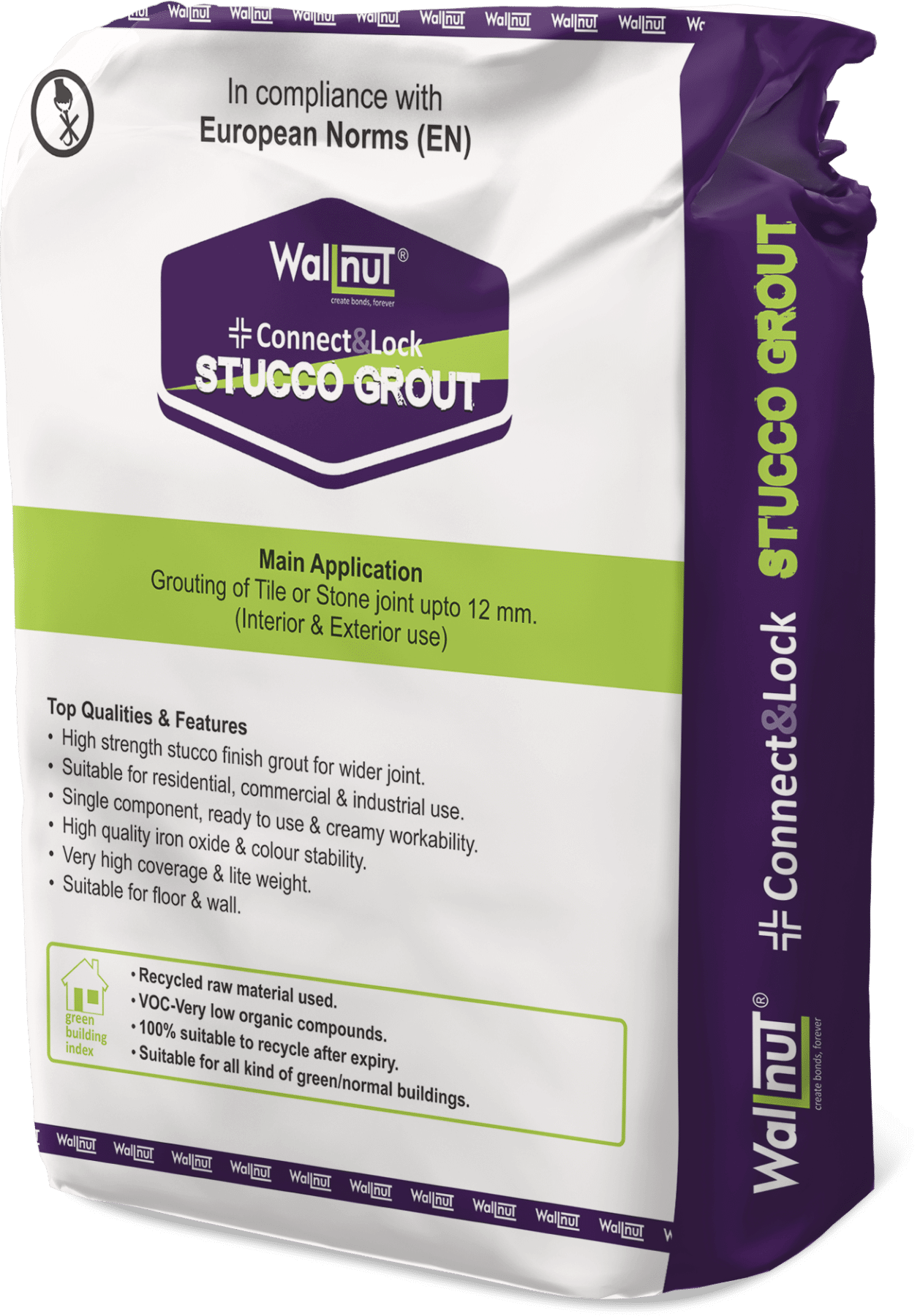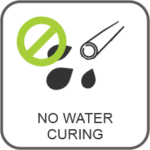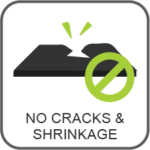Connect & Lock
Stucco Grout
Polymer stucco grouts for filling joints between tiles & stone up to 12 mm.
Polymer tile grout is cement-based with added polymers that are activated once they come in contact with water. The chemical reaction increases the grout’s water, abrasion, and chemical resistance and adds an incredible amount of strength. Polymer tile grout is a single component material that is completely stain-proof. polymer-based grout is not recommended to be used with pebbles, Should not be used in submerged water or anywhere with high steam.

Available in
WEIGHT
- 10
KG
- 01
KG
- 0.5
KG
COLOR
PACK

In Compliance With
EN norms – CG
Wallnut Connect & Lock Stucco grout is a single component, ecofriendly, high polymer modified, water & abrasion resistance grout based on high-quality mineral for filling the joints of tiles & stone up to 12mm. Suitable for internal & external areas
Stucco Grout Hi-Tech Features



- High compressive, abrasion & water resistance among polymer class of grout.
- Best of workability, cleaning, and smooth glossy finish.
- Very high quality of Iron oxide and colour stability.
- Guaranteed for quick filling of joint up to 12 mm. on the floor & on the wall.
- Best to use for industrial-grade tiles, paver tiles with wider joints.
- No water curing requires.
- Stucco tile grout is suitable for external & internal.



- High coverages with the best of performance even in fine joints.
- Economic & best value using Wallnut Stucco as tile grout.
- High compressive, abrasion and crack resistant
- Economic & best value using Wallnut Stucco as tile grout.
- Very low VOC and suitable for green building credit points.
Best area for Stucco Grout
Entryways, Industrial-grade tiles, paver tiles with wider joints.
Commercial spaces, High-traffic residences
Kitchen counters and backsplashes
How to use Stucco Grout
- All types & sizes of ceramic & vitrified tiles.
- All types & sizes of ceramic & glass mosaic.
- All types of natural and recomposed stone.
- Large-format tiles slab of all types.
- First, check that tiles or stones are fixed properly and are not sounding hollow. In case sounding hollow, the first repair or replace the area.
- Ensure that joints are clean and free from all foreign material such as oil, grease, dust, etc. In case the dust or cement particles are stuck inside the joint, use a vacuum cleaner or blower to remove the same. The Grout remover tool also can be used in case old grout to be removed.
- In case working on an external façade or on floor joints, avoid applying grout on hot surfaces. First, let cool the surface of tiles or stone and don’t work under direct sun. A hot surface may compromise the final performance grout. In case of high absorbent tiles or stone surfaces, before starting the application, first, apply the grout colour in a small test patch area. In case discolouration of the surface occurs, then consult Wallnut technical representative and stop the application.
- In case tiles or stone are rustic in nature and having uneven surfaces, it is possible that grout residual will remain on the surface while final cleaning. It is better to avoid applying grout on the entire surface area. In this case, edges of tiles or stone can be masked by applying suitable masking tape and can be removed post-cleaning of grouts.
- Mix Lite Joint Grout With approx. 2.75 L / 10 Kg. of clean water. Use slow speed electric stirrer for mixing to have desirable results.
- Manual mixing can compromise the performance of grout and colour can be uneven on the final surface.
- Adjust the water quantity as per ambient temperature and dryness of the surface and joints. The final mix must be a workable paste.
- Spread the grout evenly on the surface of tiles or stone to cover the area.
- Once the grout is spread, fill the joint tightly using a rubber grout float. Keep the rubber float diagonally to the joint and apply a 45-degree angle to have a perfect filling.
- Once all the joints are filled properly, remove excess grout if any from the surface of tiles or stone.
- Leave the grout for the surface to touch dry. Once the top surface of grout becomes semi-dry, apply all over the surface cleaning sponge using very little water. Use the water only enough to wet the surface area. Apply the sponge in a circular motion all over the joints. Finish the joint smoothly and evenly. (In case excess water is used, it is possible that pigments from the top surface are washed away and the final color of grout may be affected).
In compliance with EN 13888 : EN CG standard for class 1 & class 2 polymer modified grouts
Compressive strength : ≥ 30 N / mm2 : As per EN 12808-3
Flexural strength : ≥ 3.5 N / mm2 : As per EN 12808-3
Abrasion resistance : ≤ 2000 mm3 : As per EN 12808-2
(Final results @ 28 days. 23* C. & 50% humidity)
• Final resistance to temperature after 28 days or full cure: - 30 to + 80 * C.
• The final results may vary based on temperature and humidity.
Keep in Touch
Get in touch for business and product acquisitions enquiries.
For Enquiries
91-22-49713322
91-9967007783
Email
info@wallnut.co.in

